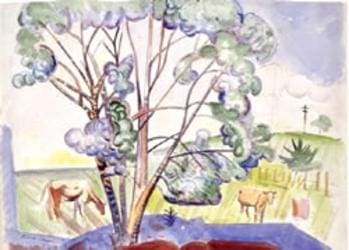Close to Home: Watercolors by William Sommer and Raphael Gleitsmann
Judith Bear Isroff Gallery
Two of Northeast Ohio’s most important historic artists, William Sommer (1867-1949) and Raphael Gleitsmann (1910-1995) spent the 1930s and 1940s examining regional life. This exhibition explores how each artist, in his own way, depicted subjects that were characteristic of this part of the country. All the works on view are from the museum’s collection, which contains major holdings by the two artists.
Although William Sommer’s watercolors were painted during the Great Depression and World War II, they do not reflect those tumultuous times. The artist chose instead to paint personal, familiar subjects and to capture the tranquility of his life in the rural Brandywine Valley, which is now part of the Cuyahoga Valley National Park. The farmhouses set beside hilly roads in Along the Brandywine and the cows grazing on a lazy summer day in Purple Pattern were inspired by the land around his home. Sommer’s portraits were intimate portrayals. They focused on friends and family, including the neighborhood children, his wife Mart and family friend Eunice Merton, who was the first female president of the Summit County Farm Bureau.
In contrast, Raphael Gleitsmann viewed people and landscapes from a distance. Many of his urban and rural scenes alike are tinged with alienation and melancholy, hinting at his own personality as well as at the troubled times. Images of loneliness include a solitary man walking down a desolate, snow-covered street and a distant view of a farmer working alone in the fields. Gleitsmann also illustrated hopeful aspects of American life during this era, from American technological advancements such as the railroad system, telephone poles and oil refineries to children frolicking in the snow.
For Gleitsmann, a young man just starting out during the Depression and soon to go fight in World War II, the industrial and rural landscapes of the region evoked senses of isolation and uncertainty. Sommer, nearing the end of his career, enjoyed the comfort of focusing on daily life in the countryside. Both artists captured the look and spirit of this area during the 1930s and 1940s, but from two very different viewpoints.
This exhibition is made possible by a generous gift from the Robert O. & Annamae Orr Foundation.

